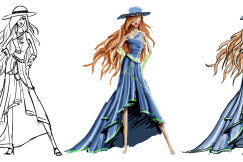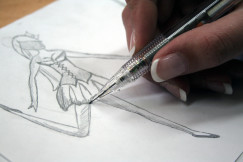Fashion Capitals of the World
By: Fashion School USA | May 14th, 2014 | Comments

Fashion School Infographic
Fashion Capitals
A fashion capital is a city which has a major influence on international fashion trends and in which the design, production and retailing of fashion products – plus events such as fashion weeks, awards and trade fairs – generate significant economic output.
Definition
Fashion capitals usually have a broad mix of business, financial, entertainment, cultural and leisure activities are internationally recognized for having a unique and strong identity. It has also been noted that the status of a fashion capital has become increasingly linked to a city’s domestic and international profile. Fashion capitals are also likely to be part of a wider design scene, with design schools, fashion magazines and a local market of affluent consumers.
History
2011s – A 2011 issue of Fashion Theory: Journal of Dress, Body and Culture explored the move away from the traditional dominance of five key cities (London, Milan, New York, Paris, Tokyo), with co-editor Lise Skov suggesting what she described as a “poly-centric” fashion industry developing in the 21st century.
2007s – Since 2007, Berlin has been highlighted as an increasingly important center for global fashion trends.
1980s – In the 1980s, Tokyo claimed its place as a fashion capital with a new generation of avant-garde designers, include Issey Miyake and Rei Kawakubo of Comme des Garcons gaining worldwide attention.
1970s – Florence re-emerged as a leading city in haute couture, although focus shifted to Milan from the 1970s on as leading design houses moved to the city.
1950s – During the 1950s Italy rose in prominence again.
1940s – New York City rose in stature as a fashion capital, challenging the dominance of Paris with a different approach, especially in its development and popularization of sportswear as fashion during the 1940s and 50s.
19th Century – During the 19th century, with a powerful British Empire and a young Queen Victoria on the throne (from 1837), London once again became a major fashion leader.
17th Century – In the 17th century, as the Renaissance started to fade away, with the power of the French court under Louis XIV, Paris established itself as Europe’s main fashion center.
16th Century – Progressing into the late-16th century, with influence of the English Royal Court, London became a major city in European fashion.
Fashion Schools
- Miami University of Art & Design
Miami, FL MIAMI
- Fashion Institute of Technology
New Yrok, NY FIT
- SUNY Oneonta
Oneonta, NY SUNY
- East Carolina University
Greenville, NC ECU
- Albright College
Reading, PA AC
- Oregon State University
Corvallis, OR OSU
- Woodbury University
Burbank, CA WU
- Academy of Art University
San Fancisco, CA AAU






